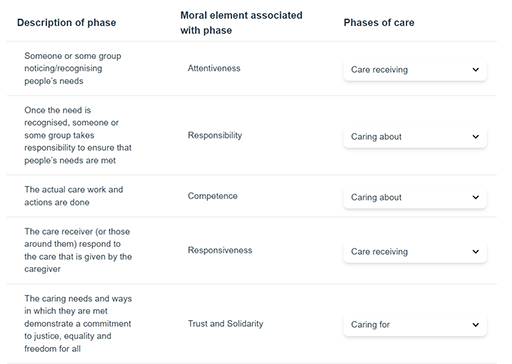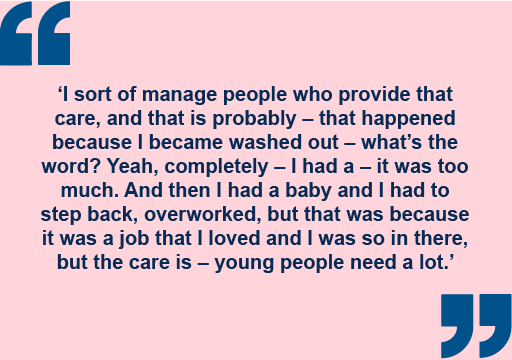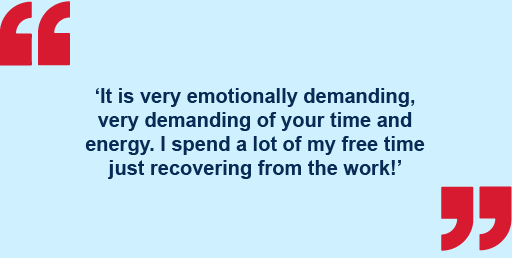Use 'Print preview' to check the number of pages and printer settings.
Print functionality varies between browsers.
Printable page generated Saturday, 22 November 2025, 10:07 AM
2: What does it mean to ‘care’?
2: What does it mean to ‘care’?
Why is it important to look at ‘care’ and how might this concept fit with your professional practice? If you work in social care, you will be very familiar with the concept of care as the core of social care professional values, theory and practice. This is evident in the idea of a ‘duty of care’ which underpins ethical practice, though some argue it is easy for the concept to get lost in the ‘managerialisation’ of social work (see Meagher and Parton, 2004), whilst others point to the significant negative impacts of austerity (Hadwin, 2022). But ‘care,’ when you think of the word in its broadest sense, can mean a lot of different things to a lot of people. On the surface, the term seems simple, even common sensical, because it is deeply embedded in our everyday language. Generally, it evokes a sense of concern outside of yourself and your own interests. The opposite of this might be to state a negative claim, ‘I don’t care’.
Importantly, you might think about care in different ways depending on the situation and context. Do people think about care in the same way if they are at work compared to at home, with their families? Is this different than giving money to charity because you cared about something you saw on television?
 Activity 2.1: Care across boundaries of personal/professional practice
Activity 2.1: Care across boundaries of personal/professional practice
When you think of the word ‘care’, what does it mean to you? Take some time to think about care as it relates to your own family life and then what comes to mind when you think about care in the context of your professional practice.
| ‘Care’ in the context of my own family life | ‘Care’ in the context of my professional practice |
Discussion
How did your thoughts on care differ?
People can think about care in quite different ways depending on what ‘hat’ they are wearing at the time. For example, you might think of your own children as more vulnerable than someone else’s child of the same age. This is quite normal; after all, you know your own children better than other peoples’. Nevertheless, it is worth reflecting on why we do this and how that influences our ideas and thoughts about other children.
You will learn more about this in the next section.
2.1: Different approaches to care
Research literature suggests that we can broadly understand ‘care’ to include both practical and emotional support that we undertake on behalf of other(s). Care involves the things that we do, our practices, and the feelings, disposition or values towards those actions (Tronto, 1993). Another way to think about this is to see ‘care’ as ‘caring for’ (tending to someone else’s needs) and ‘caring about’ (emotional concern for another). It is possible to ‘care for’ someone without really ‘caring about’ them. There is a tendency to think of care as flowing in one direction – an active caregiver and a cared-for recipient. However, there are many examples of care relationships that are reciprocal, where we are both the givers of care and the receivers of care. When we thinking of caring for the elderly, disabled, young people, friends or workmates, it is easy to see how care might come in different forms, involve different exchanges of care over a long period of time, as well as be open to power inequalities (Bowlby, 2012).
The care literature also makes a distinction between ‘formal’ and ‘informal’ types of care. These somewhat blurry distinctions came about because some carers see what they do as ‘work’ whilst others see it as something more reciprocal and loving (Milligan and Wiles, 2010). Formal care is usually paid and formally organised. Informal care is usually unpaid but highly diverse and may include anything from everyday acts of concern to sustained care over time. A key point is that the boundaries between formal and informal care are blurred. Formal care might become extended into an informal relationship over time. Your relationships with the young people in your care may be fleeting but there may be others that have endured over time.
One widely well-known approach to care is the ‘ethics of care’ framework, which suggests that care involves taking a social, moral and political position (Fisher and Tronto, 1990; Tronto, 1993). For example, society decides who gets to be cared for and how, what institutional rules and resources might govern that care and the related practices. The Covid-19 pandemic offered a good example of how the social, moral and political decision-making connect to each other. The decision to release hospitalised elderly who were testing positive for Covid into care homes was a political decision with significant social and moral implications. Moral decisions may be based on limited resources and geographical inequities. Similarly, research suggests that political decision-making made it ethically challenging for social workers to operate during the Covid pandemic (Banks et al., 2020)
Let’s look more closely at the key features of the ‘ethics of care’ framework.
 Activity 2.2: Phases and moral elements of care
Activity 2.2: Phases and moral elements of care
Below are the phases of care developed by Fisher and Tronto (1990, pp. 40, cited in Tronto (2013 pp. 22)) and the five moral elements of care (see also Collett et al., 2018).
Link the five moral elements to their associated phase and explanations element.
- Trust and solidarity
- Responsibility
- Competence
- Responsiveness
- Attentiveness
Click ‘View interactive version’ to get started with the activity.

Discussion
What did you think about these phases of care? Do you recognise these within your own practice? One of the criticisms of this model is that it doesn’t include some of the elements associated with informal caring such as reciprocity. In many care relationships (such as friendships), care may be reciprocal, even when it is unequal in power. Care may change over time. Care is ‘embodied’ which means that there is some form of ‘co-presence’ through physical contact or non-verbal communication (Bowlby, 2012).
2.2: Care, professional practice and emotions
 Pause for reflection: Maintaining a caring approach
Pause for reflection: Maintaining a caring approach
It is well understood that working with vulnerable unaccompanied child migrants can be a challenging and an oftentimes emotionally draining job.
What helps a practitioner to maintain a caring and empathetic approach in your work? What has helped you personally?
Make some notes in the box below.
The challenges of working on a daily basis with very vulnerable unaccompanied migrant children are well known – complex caseloads, challenging client situations (including emotional trauma and high volumes of work), and a lack of resources, all point to high emotional demands (Griffiths et al., 2019). Providing care for UASC young people often competes with other systemic, legal and professional demands. The sense of fatigue and burnout was present in our data from across a variety of sectors.
Ophelia, who worked in the education sector, told us how she moved from direct work with UASC to managing other people, something that was quite a common approach for managing the emotional challenges of these roles:
Charlie, who worked directly with young people within the charity sector told us:
Research studies with social workers working directly with young people suggest that an emotional commitment towards young people is the key to the most effective practice (Kohli, 2006). This is also very challenging because social workers in the same study also felt like they were sometimes the containers or conduits for traumatic stress. They described how ‘bearing witness’ can be very difficult. The literature also characterises the emotional toll as burnout syndrome, leading to exhaustion, cynicism, emotional distancing and depersonalisation or Secondary Trauma Stress (STS), in which repeated exposure to others’ trauma has an impact on emotions, behaviours, beliefs and values (Hadwin, 2022; Vîrgă et al., 2020).
Therefore, we know that care – when we look at it from the wider perspective as presented in the literature – has both practical and emotional entanglements that are often difficult and challenging for those working in practice (Milligan and Wiles, 2010). This is especially true for those working within a system and broader environment where the day-to-day pressures seem to work against being able to exercise care that can sit in conflict with the Corporate Parenting principles. At the same time, young people can struggle to communicate and feel understood about their own care needs and life experiences. In addition, young people’s own caring relationships are often neglected or misunderstood. The reality is that social workers who work with Unaccompanied Asylum-Seeking Children (UASC) face many ethical dilemmas and conflicts of interests. On the one hand, building honest, trustful and supportive relationships whilst also complying with resource and asylum requirements (Wright, 2014).
 Activity 2.3: Thinking about emotions
Activity 2.3: Thinking about emotions
When you think about your work with UASC, what are the three emotions that spring to mind? You may find it easier to use similes to express yourself, for example, ‘Working with UASC is like…’
Make some notes in the box below.
2.3: Section summary
In this section, we have drawn on the academic literature to think about the different ways that we can frame the concept of care. These framings acknowledge that care can be both complex and challenging. However, quite a lot of this literature looks at care with a focus on adults (e.g., elder care) and that when we think about care in childhood, there are other key issues to be taken into account.
In the next section, we are going to explore ‘care’ and ‘childhood’ as interactional concepts.
Now, continue to 3: ‘Care’ and ‘Childhood’.





